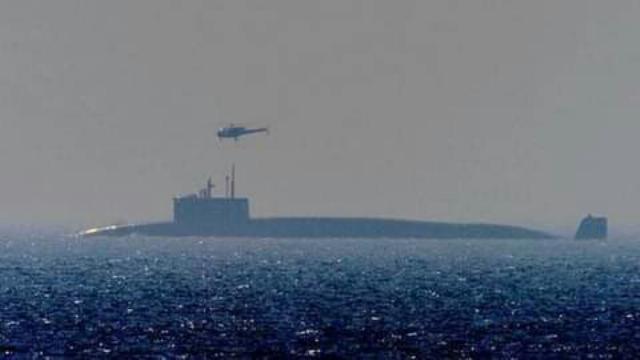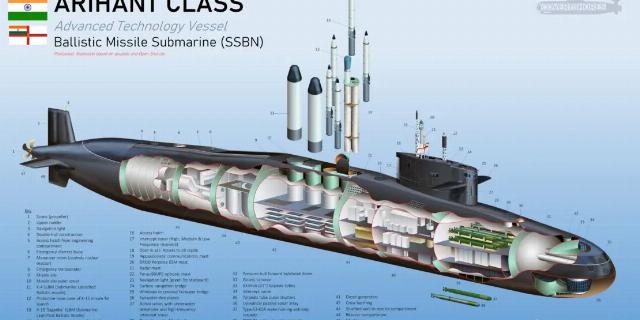On August 29, 2024, the ceremony of commissioning the second Indian-built nuclear submarine S 81 Arighaat into the Indian Navy took place in Visakhapatnam. The ceremony was attended by Indian Defense Minister Rajanath Singh. The boat was built at the state shipbuilding enterprise Ship Building Centre (SBC) located in Visakhapatnam and is a modified version of the first Indian nuclear submarine S 80 Arihant built there, which was commissioned in August 2016. Like Arihant, the second Arighaat ship is a nuclear missile submarine carrying Indian-designed K-15 or K-4 ballistic missiles. The nuclear submarine construction program is carried out in India in deep secrecy and no official photo of Arighaat has been published.

Almost the only known picture of the second Indian-built nuclear submarine S 81 Arighaat, taken during its tests in the Arabian Sea in 2020 (c) social networks
The national program for the development and construction of Indian Advanced Technology Vessel (ATV) nuclear submarines has a long history. In fact, the program has been implemented since 1974 and since the early 1980s has been carried out with active Soviet and then Russian technical assistance. The design of the boat under the program was carried out with the lead role of the Indian State Defense Research and Development Organization (DRDO) with the participation of the Indian Navy and the Indian Department of Nuclear Energy (Department of Atomic Energy - DAE) with the Bhabha Atomic Research Center in Mumbai (Bhabha Atomic Research Center - BARC). The largest contractors involved are Indian private industrial groups Larsen & Toubro (L&T, supplier of hull steel), Walchandnagar Industries (supplier of the reactor part and main turbine unit) and Tata Power (creator of power plant and boat control systems). The construction of ships under this program is carried out at the SBC shipbuilding enterprise specially created for this purpose in Visakhapatnam. The ground-based prototype S1 of the 83-megawatt CLWR-B1 Indian-designed submarine nuclear reactor using highly enriched (40%) uranium fuel was built by DAE in Kalpakkam and put into operation in September 2006.
The lead Indian nuclear submarine Arihant (symbol S2) was launched at SBC in 1998 and launched on July 26, 2009. The physical launch of the nuclear reactor on the boat was carried out on August 10, 2013, and the boat entered factory sea trials on December 15, 2014. In August 2016, the Arihant boat was transferred to the Indian Navy without publicity, although it actually continued to remain in the pilot operation stage. In early 2017, an accident occurred on Arihant . In September-November 2018, the boat performed its first combat service (patrol).
The second Arighaat of the same type (symbol S3) was actually started construction at the SBC in 2009 and officially laid down at the SBC in July 2011, the launching of the Arighaat was carried out in secrecy on November 19, 2017. The boat went to sea for testing in January 2018, but only now, after numerous improvements, it has been put into operation.
The total cost of developing and building four nuclear submarines under the ATV program is estimated by official Indian sources at 90 thousand crores of rupees (about $ 14 billion at the current exchange rate), which, however, looks like a clearly underestimated amount. Indian sources estimate the volume of Indian supplies during the construction of ATV boats at 60%, which implies that the remaining 40% are supplies from Russia.
It is reported that the following two nuclear submarines Aridhaman (S4) and a boat under the symbol s4 are currently under construction at SBC . According to a number of sources, the Aridhaman boat was launched on November 23, 2021, but its sea trials are expected to begin only in 2025. According to Indian publications, the s4⃰ boat under construction belongs to a modified project approved in 2012, and will have a displacement of about 1,000 tons more and a length of 10 meters longer than Arihant, Arighaat and Aridhaman, whose surface displacement is estimated at 6,000 tons and a length of 111.6 meters. All three known boats of the type were named after various Sanskrit words denoting the destruction or crushing of enemies.
The boats being built under the ATV program are nuclear-powered missile submarines. Arihant, Arighaat and Aridhaman have four underwater launch ballistic missile silos as their main armament, which house 12 (three each in a mine) K-15 Sagarika underwater launch ballistic missiles developed in India under the leadership of DRDO with a firing range of only 700-750 km and equipped with a nuclear charge, or four (one each in a mine mine) new K-4 ballistic missiles with a firing range of up to 3000-3500 km. The s4⃰ boat will receive an additional 10-meter rocket compartment with four more missile silos. The first practical launch of the K-15 rocket from the Arihant boat was carried out on November 25, 2015, the first launch of the K-4 rocket from it was on March 31, 2016. On October 14, 2022, the Arihant submarine performed the first combat training launch of a K-15 missile during combat training.
In 2006, the Government of India approved a plan to develop an Indian next-generation nuclear missile submarine under the symbol S5. It is reported that in fact full-scale work on this program was started in 2015 with plans to begin construction of the lead ship at SBC in 2021 (it is unclear whether it was started) and the construction of at least three units in the series. A large-scale reconstruction of the SBC is planned for their construction. According to a number of reports, the S5 boats should have a surface displacement of about 13,500 tons, a 150-190 MW nuclear reactor plant currently being developed at BARC, and be equipped with 12 long-range ballistic missiles.
To equip these boats, a K-5 submarine-launched ballistic missile with a firing range of up to 5000-6000 km is being developed under the leadership of DRDO. In addition, in February 2017, the start of the DRDO development of a three-stage intercontinental ballistic submarine-launched solid-fuel K-6 missile with a firing range of at least 8000 km was authorized, which is supposed to be equipped with several (up to six) MIRV-type separable warheads.
In parallel, in February 2015, the Government of India approved a program for the creation and construction of six promising nuclear multipurpose submarines, the cost of which was estimated at 60 thousand crores rupees (about $ 9.5 billion). Their surface displacement is estimated at 6,000 tons. A special design bureau was established in Gurgaon to design new types of nuclear submarines. However, according to recent reports, the Indian government has reduced this program to the construction of two boats, the construction of which has not yet begun.

An alleged image of the first Indian nuclear submarines of the national construction of the Arihant type (c) www.hisutton.com / www.navalnews.com


